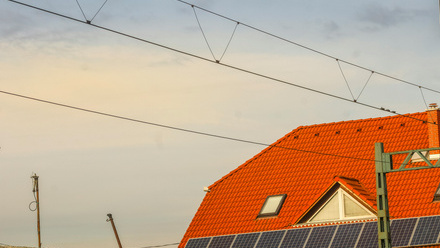Building sustainability in stainless steel
Stainless steel is a durable and long-lasting material for façades, interiors and other applications. With considered procurement, the material can enable designers to reduce carbon footprint.
This may seem counterintuitive. After all, the steel industry is responsible for around 5% of global CO2 emissions. In addition, stainless steel has a higher carbon footprint than carbon steel on average as it contains various alloying elements like nickel, molybdenum and chromium for optimum performance in its large field of applications.
However, leading stainless steel producers have already implemented technology and procedures to significantly reduce carbon footprint. In addition, it is possible to use sophisticated control and monitoring to certify architectural grades with an even lower footprint.
Cutting the average carbon footprint
Even though stainless steels from different suppliers may be identical in terms of chemistry and mechanical properties, their carbon footprints may be radically different. That is because of variation at the steel mills, and differences in the energy mix used to power melting, annealing and rolling processes under Scopes 1 and 2. It also relates to embodied energy in raw materials such as alloying elements under Scope 3. These are often the largest contributor to carbon footprint.
It is essential to understand the contribution of emissions under all three scopes as the market is complex. For example, Outokumpu with its own ferrochrome mine, counts chromium production under Scope 1, whereas suppliers that source it externally would put chromium under Scope 3.
Improvements in production and sourcing have made it possible for us to achieve a carbon footprint of 1.8 tons of CO2 per ton of crude stainless steel, measured as an average across our entire production.
This is significantly lower than the European average, which is 2.8 tons of CO2 per ton, according to a 2021 report by the Carbon Disclosure Project (CDP). Outokumpu's low carbon footprint is made possible by using a high percentage of recycled scrap as raw material, which significantly cuts emissions as processing scrap requires significantly less energy than raw virgin ores.
Using scrap also enables the use of Electric Arc Furnace (EAF) technology, which can be powered by low-carbon electricity. This compares to the traditional steelmaking technique of using a blast furnace fuelled by coal or coke to process virgin ones.
Therefore, scrap cuts overall energy consumption and enables a switch to clean energy with no loss in product quality. Stainless steel can be recycled an infinite number of times while preserving its mechanical and chemical properties. This contrasts with aluminium, where it is not always possible to remove contaminants during recycling, which can impact the material's properties. As a result, architectural aluminium for aesthetic cladding tends to be entirely based on virgin material.
Product-specific carbon footprint
Greater control and measurement in the steel mill is enabling designers to cut carbon footprint further.
While many suppliers publish carbon footprint data, it is typically based on average data from across their entire portfolio. This conceals a variation in carbon footprint between different grades. The carbon footprint of a stainless steel product depends on the production route, processing steps and the level of alloys such as nickel, molybdenum and chromium.
Architectural stainless steels such as grade 316L have relatively low alloying content, so can contain a high percentage of scrap material. In contrast, other industries need highly-alloyed grades so that equipment can withstand exposure to corrosive chemicals such as acids, alkali and seawater.
In general, the higher the alloying content, the higher the carbon footprint. Therefore, as they usually specify relatively lean alloys, designers can source material with a lower carbon footprint than the average figure.
This relies on a new type of certification that has been possible since November 2022, when we became the first producer to issue certificates with a product-specific carbon footprint when delivering material. The methodology for this is based on the ISO 14067 standard for carbon footprints. It uses measured production data over a 12-month rolling average and covers Scopes 1-3.
Because it is based on a 12-month rolling average figure, it is difficult to put an exact figure on the potential saving as this will vary. However, we have been able to produce grade 304L as cold rolled product with a product-specific carbon footprint of 1.4 tons of CO2 per ton of stainless steel. Being cold rolled, this covers cradle to gate processes across the full scopes 1-3. This is significantly less than our average figure of 1.8 tons of CO2 per ton of stainless steel in crude form (that has not been hot and cold rolled).
This could make a significant difference to a large façade project, which may require more than 1000 tons of stainless steel.
Demand full transparency
It is also worth being aware of another drawback when working with carbon footprint data. Sustainability certification is developing fast. Although the standards are helpful in providing a structure to calculate and certify environmental impact, there is room for intepretation in the standards. Different data sources and assumptions can be applied.
This can create a false comparison; therefore it is not always possible to directly compare data from two manufacturers, even if their data have been calculated using the same methodology.
It is possible to get round this by requesting the underlying data and an explanation of the methodology and assumptions that were applied. Consulting engineers can use this to rework data from multiple producers so that they can be compared on a like for like basis.
The next step: emissions-minimised stainless steel
The next step in cutting emissions is a new breed of emissions-minimised stainless steel, such as our Circle Green product line. Its carbon footprint is only 8% of the global average (or around 50% less than our average). This is made possible by optimising emissions at every step of production from sourcing of raw materials, through the stainless steel melt, energy production and transport.
The first batch of emissions-minimised product was delivered to Fiskars Group, the design-driven cookware brand, in June 2022. In the long term, the vision is to develop a product line to satisfy rapidly growing demand for sustainable products from consumer facing industries including consumer products, appliances and automotive, as well as in architecture.
Good design and longevity
Ultimately, the most important factor in sustainable construction is longevity. People value buildings that are beautiful, durable and fulfil their needs.
As a material, designers can use stainless steel to create façades that last through its excellent corrosion resistance and mechanical strength. A study by Yale University in 2015 found that stainless steel products in buildings and infrastructure have an average lifetime of 50 years and that 85% of this is collected for recycling into new products at the end of its life.
Stainless steel offers designers choice in terms of textures, colours and surface finishes. However, its durability also provides control over the future of their buildings. That means they can be certain that the surface finish will remain in near-pristine condition for many decades, like the spire of the 1930 Chrysler building in New York.
This article first appeared in AT Journal issue 146




